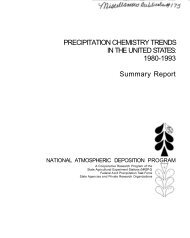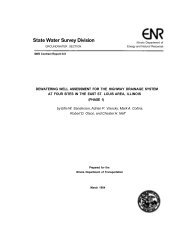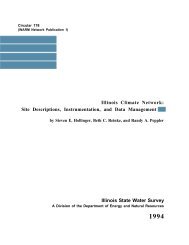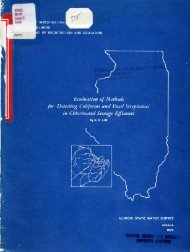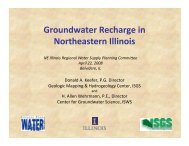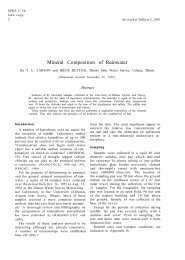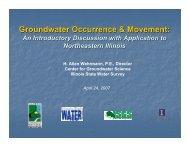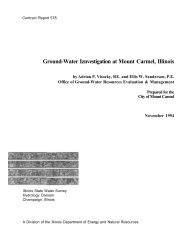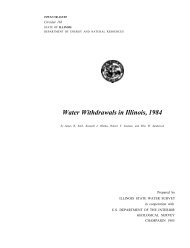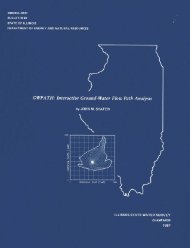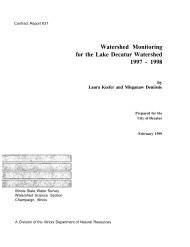Ground-water development in East St. Louis area, Illinois. Urbana, IL ...
Ground-water development in East St. Louis area, Illinois. Urbana, IL ...
Ground-water development in East St. Louis area, Illinois. Urbana, IL ...
Create successful ePaper yourself
Turn your PDF publications into a flip-book with our unique Google optimized e-Paper software.
After critical <strong>water</strong> levels have been reached, <strong>in</strong>dividual<br />
wells <strong>in</strong> pump<strong>in</strong>g centers will have yields exceed<strong>in</strong>g 450<br />
gpm.<br />
Table 33. Critical Nonpump<strong>in</strong>g Water-Level<br />
Elevations for Exist<strong>in</strong>g Pump<strong>in</strong>g Centers<br />
Pump<strong>in</strong>g center<br />
Average<br />
critical nonpump<strong>in</strong>g<br />
<strong>water</strong>-level elevation<br />
(ft above msl)<br />
Alton <strong>area</strong> 375<br />
Wood River <strong>area</strong> 369<br />
Granite City <strong>area</strong> 374<br />
National City <strong>area</strong> 374<br />
Monsanto <strong>area</strong> 369<br />
The electric analog computer with a pump<strong>in</strong>g period<br />
of 5 years was used to determ<strong>in</strong>e pump<strong>in</strong>g center discharge<br />
rates that would cause <strong>water</strong> levels <strong>in</strong> all major<br />
pump<strong>in</strong>g centers to decl<strong>in</strong>e to the critical stages <strong>in</strong> table<br />
33. Several values of discharge were assumed and <strong>water</strong>level<br />
decl<strong>in</strong>es throughout the <strong>East</strong> <strong>St</strong>. <strong>Louis</strong> <strong>area</strong> were<br />
determ<strong>in</strong>ed. Water-level decl<strong>in</strong>es were superposed on the<br />
1900 piezometric surface map together with changes <strong>in</strong><br />
Figure 64.<br />
Thickness of medium sand and coarser deposits<br />
<strong>in</strong> lower part of valley fill<br />
<strong>in</strong> the Granite City <strong>area</strong>, 30 feet <strong>in</strong> the National City<br />
<strong>area</strong>, and 30 feet <strong>in</strong> the Monsanto <strong>area</strong>.<br />
When pump<strong>in</strong>g <strong>water</strong> levels <strong>in</strong> <strong>in</strong>dividual production<br />
wells are below tops of screens, partial clogg<strong>in</strong>g of<br />
screen open<strong>in</strong>gs and the pores of the deposits <strong>in</strong> the immediate<br />
vic<strong>in</strong>ity of the wells is greatly accelerated. To<br />
<strong>in</strong>sure long service lives of wells, pump<strong>in</strong>g <strong>water</strong> levels<br />
should be kept above tops of screens. Also, when <strong>water</strong><br />
levels decl<strong>in</strong>e to stages below the top of the coarse alluvial<br />
and valley-tra<strong>in</strong> sand and gravel and more than<br />
one-half of the aquifer is de<strong>water</strong>ed, drawdowns due to<br />
the effects of de<strong>water</strong><strong>in</strong>g become excessive and the yields<br />
of wells greatly decrease. Thus, critical <strong>water</strong> levels occur<br />
when pump<strong>in</strong>g <strong>water</strong> levels are below tops of screens,<br />
or more than one-half of the aquifer is de<strong>water</strong>ed, or<br />
both.<br />
Critical nonpump<strong>in</strong>g <strong>water</strong> levels for exist<strong>in</strong>g pump<strong>in</strong>g<br />
centers (table 33) were estimated on the basis of<br />
well-construction and performance data and figures 6, 64,<br />
and 65 tak<strong>in</strong>g <strong>in</strong>to consideration the effects of de<strong>water</strong><strong>in</strong>g.<br />
Figure 65. Estimated available drawdown to top of<br />
medium sand and coarser deposits <strong>in</strong> June 1962<br />
58




